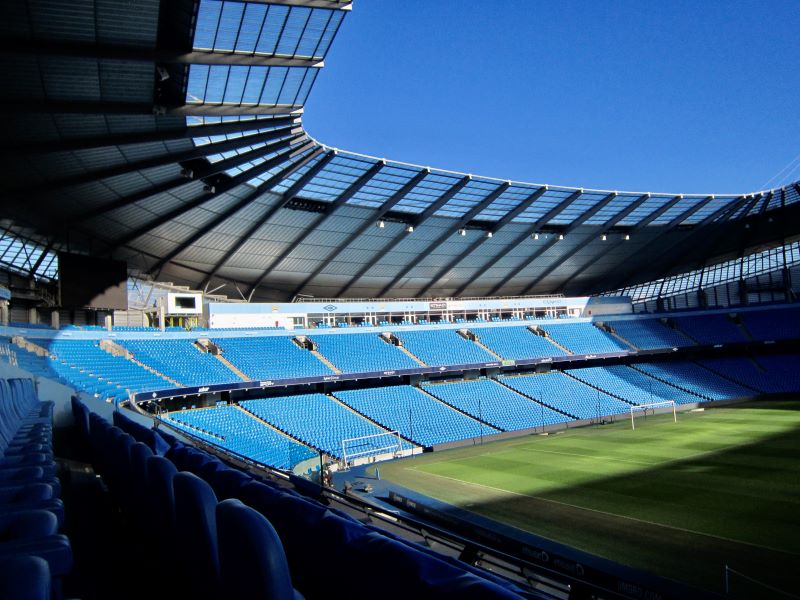Table of Contents
ToggleThe Premier League Manchester City Stadium, Etihad Stadium
Name: City of Manchester Stadium
Location: Etihad Campus, Manchester
Owner: Manchester City Council
Capacity: 56,000
Record attendance: 54,693 (Manchester City vs Leicester City, 6 February 2016)
Opened: 10 August 2003 (as football stadium)
The City of Manchester Stadium, known also as the Etihad Stadium, stands as a symbol of sporting excellence in the heart of Manchester. Home to Premier League giants Manchester City, this iconic stadium has seen its fair share of sporting history.
It has a domestic capacity of 55,000 and ranks as the sixth-largest football stadium in England and the ninth-largest in the United Kingdom.
Let’s dive into the history, architecture, and significance of the Etihad Stadium.
Etihad Stadium History
The story of the Etihad Stadium starts with Manchester’s desire to host major sporting events. Plans for a new stadium in Manchester were initially conceived as part of the city’s bid to host the 1996 Summer Olympics. Manchester City Council submitted a bid that proposed an 80,000-capacity stadium on a greenfield site west of Manchester’s city center, but Atlanta was awarded the Games.
Converting the stadium for football wasn’t without its challenges. The athletics track was removed, and the pitch was lowered to create a lower tier of seating. Temporary stands were dismantled and replaced with permanent structures, increasing the stadium’s capacity to around 48,000.
One of the most followed Premier League football clubs in the world, Manchester City officially moved to the Etihad Stadium in the 2003-04 season. The conversion cost the city council £22 million for the track, pitch, and seating, while the football club invested £20 million in additional facilities such as bars, restaurants, and corporate entertainment areas.
Etihad Stadium Expansion & Architecture
The Etihad Stadium’s expansion continued over the years. The South Stand was extended in 2015, adding a third tier and increasing the stadium’s capacity to approximately 55,000. The North Stand is set to undergo redevelopment, with plans for a new hotel, a covered fan park for 6,000 people, and an increased net capacity of 61,474, making it one of the nation’s largest club grounds.
The Etihad Stadium features a distinctive roller-coaster-like roof, visible from afar, held up by a tensioned system of cables and masts. The roof design is groundbreaking, making efficient use of materials and creating a visually striking stadium. What sets the Etihad Stadium apart is its attention to detail, focusing on crowd comfort, ease of access, and the overall spectator experience.
The stadium’s pitch is designed to maximize sunlight exposure, with a translucent polycarbonate band at the roof’s periphery. The corners of the stadium without seating have perforated walls with adjustable louvres to provide ventilation and airflow, contributing to the excellent quality of the grass playing surface. The pitch dimensions meet UEFA standards and are reinforced with artificial fibers to ensure durability.
Etihad Stadium Names
The stadium has had several names during its history. It was initially named the City of Manchester Stadium by Manchester City Council but has also been referred to as Eastlands, SportCity, and Manchester City Stadium. In 2011, it was renamed the Etihad Stadium as part of a sponsorship agreement with Etihad Airways.
Each side of the stadium is named after compass directions, with the West Stand named the Colin Bell Stand in honor of the former player. The East Stand is affectionately known as the Kippax by fans, a nod to the vocal east stand at the club’s previous home, Maine Road. The North Stand is often referred to as the Family Stand, while the South Stand has been called the Scoreboard End in the past.
Stadium Firsts
The Etihad Stadium has hosted lots of historic moments. The first public football match held at the stadium was a friendly between two of the most popular football clubs, Manchester City and Barcelona in August 2003. Nicolas Anelka scored the first goal, marking the beginning of an era for the club.
The 2011-12 season was particularly memorable, with Manchester City setting several records, including remaining unbeaten at the Etihad Stadium throughout the Premier League season. The stadium’s atmosphere improved over the years, but it initially faced challenges in replicating the passionate ambiance of the club’s former ground, Maine Road.
Conclusion
The Etihad Stadium stands as a testament to Manchester’s commitment to sports and development. From its origins as a bid for the 2000 Summer Olympics to its transformation into a world-class football venue, it has played a pivotal role in the city’s sporting landscape.
With its innovative architecture, capacity for over 55,000 spectators, and ongoing expansion plans, the Etihad Stadium remains a place of excitement and achievement in the world of sports. As the richest Premier League football club, Manchester City continues playing in this stadium, the Etihad Stadium will undoubtedly remain a symbol of the club’s success and a beloved fixture in the hearts of fans worldwide.


